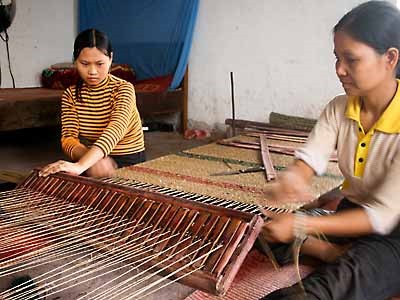Hoi sedge mats- a specialty of Thai Binh
Lan Anh -
(VOVworld)- Hoi village in Tan Le commune, Hung Ha district, Thai Binh province has been weaving mats for a long time. There are many steps involved in making a good mat, from selecting good sedge to weaving. Sedge mats, famous product of Hoi village, are now sold throughout Vietnam.
Hoi village is about 40 km from Thai Binh city. The locals worship the founder of the mat weaving craft Pham Don Le at a temple where visitors can hear stories about the craft. In the old days, the locals used vertical looms which made their loose mats that weren’t so beautiful. They changed their weaving technique to use a horizontal loom with the help of Pham Don Le, who they the honored as the founder of their craft. Pham Don Le was the first winner of a national contest in 1481. He learned sophisticated techniques for weaving sedge mats while living in China as an ambassador. Hoi sedge mats are now quite more beautiful.
 |
For many years, Hoi village has maintained the crafts. Hoi mats are popular throughout Vietnam. Ngo Duy Lien, who has been weaving mats for years, says there are 3,200 households in Tan Le commune and 80% of them weave mats producing millions of mats for the market: “The craft flourished in the 1960s and 1970s. Everyone used mats. Hoi mats are beautiful and durable, so, they are very popular”.
Hoi mats vary in patterns, weaving technique, and size. Locals spend about 8 months a year weaving mats and the rest of the year doing farm work. They used to weave mats manually but productivity was low. Now, with the help of machines, the villagers can produce more mats of better quality, generating more income. According to Ms Nguyen Thu Lua: “Manual weaving was very slow. Today the machines enable us to save time and money. We now can make 20 pairs of mats a day compared to just 1 or 2 pairs previously. Our incomes are rising. Everyone is happy”.
Hoi village is located between the Red River and the Luoc River on land ideal for growing sedges and jute, the raw materials necessary for the making mats. The mats are available in different colors to suit the taste of the customers. Rose or lotus flowers, portraits, or Chinese longevity characters are the most requested decorative patterns.
Lan Anh